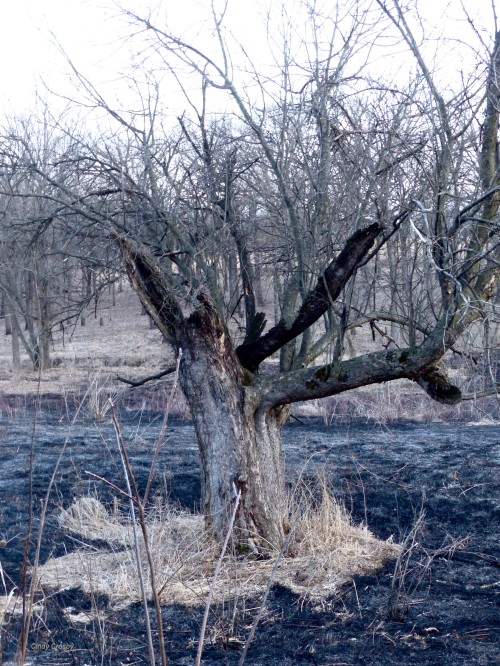“Barn’s burnt down. Now, I can see the moon.” — Mazuta Masahide
*****
Sunset. A pearl button moon rises due east as the sun flames into the western horizon. Not quite the “Supermoon” or full “Worm Moon” we’ll have on March 20, in conjunction this year with the vernal equinox. This evening, we get an almost-there version over the prairie. A sneak preview.

The prairie is partly burnt. The crew came out today and torched the first sections, leaving a yin and yang of startling contrast.

Robins flitter and hop over the white ash, scrounging for worms on the scorched surface. March is a critical month for prescribed burns on the prairie. Each morning, natural areas managers check the signs. Wind speed? Check. Wind direction? Check. Humidity? Check.
Most of the prairies Jeff and I hiked this week were still untouched by fire.

Look deep into the grasses, and you’ll see snowmelt is still pooled around the remains of Indian grass and big bluestem. Tough to burn.
Tonight, the prairie stream reflects a still-bare tree and sunset glow of cumulus clouds above.

My old touchstone, the praying mantis egg case I’ve watched through the winter, faces the dying light. It is unmarked by the flames, but empty of life.

On one side of the trail, ashes.

On the other, brittle grass stalks and old wildflower stems are prime kindling. Waiting for the burning to resume. The flattened tallgrass glimmers gold. Will the fire be tomorrow? A week from now?

On most prairies, the answer will be this: Soon.
Our old apple tree on the prairie has weathered many fires. We keep it, as it tells the story of its ancestor, an apple tree planted by the early settlers who first turned the tallgrass under the sharp knife of the plow. Trees like these once provided apples for making “Apple Jack,” an alcoholic beverage. The drink offered temporary solace and medicine for those pioneers’ hardscrabble days.

In the receding light, I wonder. Could this be the battered tree’s last spring? Every year, it surprises me by putting out green leaves and flowers.Who knows? It’s resilient. It may be here long after I’m gone.
Tonight, walking this half-burned, ghost of last year’s tallgrass, I feel a rush of joy. Out with the old. I’m ready for something new. Let’s get it finished. Bring on the burn.

The air smells like a campfire. The memory of the taste of s’mores comes unbidden to my mouth and I realize it is long past dinnertime. Cooling temperatures and the dwindling light are clues the prairie and savanna are settling in for the night. Time to go home.
The red-winged blackbirds keep up their calling contest as I hike back to the car.
American robins flutter in and out of the trees, scouting for their bedtime snacks.

It’s almost dark. A blue bird appears. His vivid sapphire is bright in last light. He bounces for a few seconds on a burned -over bit of scrub that barely holds his weight. At about an ounce, I could mail him with a postage stamp.

I watch him sway a little longer over the ashes, then fly away. I feel a little bounce in my step as well.
Happiness! Spring.
****
Mazuta Masahide (1657-1723) was a Japanese poet and samurai who was mentored by poetry master Matsuo Basho in the 17th Century in the art of haiku. Read more on haiku here.
***
All photos and video copyright Cindy Crosby (top to bottom): almost full moon over the Schulenberg Prairie, The Morton Arboretum, Lisle, IL; bridge to Schulenberg Prairie at sunset, The Morton Arboretum, Lisle, IL; March on Belmont Prairie, Downer’s Grove, IL; reflections of sunset in Willoway Brook, Schulenberg Prairie, The Morton Arboretum, Lisle, IL; Chinese praying mantis egg case ((Tenodera sinensis) ravaged by a bird, Schulenberg Prairie, The Morton Arboretum, Lisle, IL; ashes from prescribed burn, Schulenberg Prairie, The Morton Arboretum, Lisle, IL; flattened tallgrass at sunset, Schulenberg Prairie, The Morton Arboretum, Lisle, IL; old apple tree (Malus pumila), Schulenberg Prairie Visitor Station, Lisle, IL; clouds over Belmont Prairie, Downer’s Grove, IL; video clip of dusk on the prairie and prairie savanna, Schulenberg Prairie, The Morton Arboretum, Lisle, IL; Canada wild rye (Elymus canadensis), Schulenberg Prairie, The Morton Arboretum, Lisle, IL; eastern bluebird (Sialia sialis), Schulenberg Prairie, The Morton Arboretum, Lisle, IL;
****
Cindy’s March classes, announcements, and events this week:
Now Available! Tallgrass Conversations: In Search of the Prairie Spirit (with co-author Thomas Dean) is shipping from Ice Cube Press. $24.95, hardcover, full-color. Find it at fine places like The Arboretum Store in Lisle, IL: 630-719-2454; and Books on First in Dixon, IL: (815)285-2665 or at other bookstores across the Midwest.
Nature Writing: Blended Online and In-Person: Tuesday, March 18– continues at The Morton Arboretum through April 2.
March 22: Frequent Flyers of the Garden and Prairie: Dragonflies and Damselflies, Lombard Garden Club, Lombard, IL (Closed Event).
Tallgrass Prairie Ecology Online begins March 27 through The Morton Arboretum. All classwork done remotely. Register here.

Hope to see you soon. I like your old apple tree. Feel like I am getting there.
LikeLiked by 1 person
Amazing how it has held on so long! My fingers are crossed we’ll see new growth this year… I’ve gotten fond of it. Good luck with your apple orchard this season. Thanks for reading and taking time to comment, John! See you in dragonfly season.
LikeLike
There’s another mantis egg case near that one that’s still ok…at least as of last week.
LikeLiked by 1 person
Great! I bet there are a lot of them we just don’t see… Appreciate you reading this week’s post, and taking time to let me know!
LikeLiked by 1 person